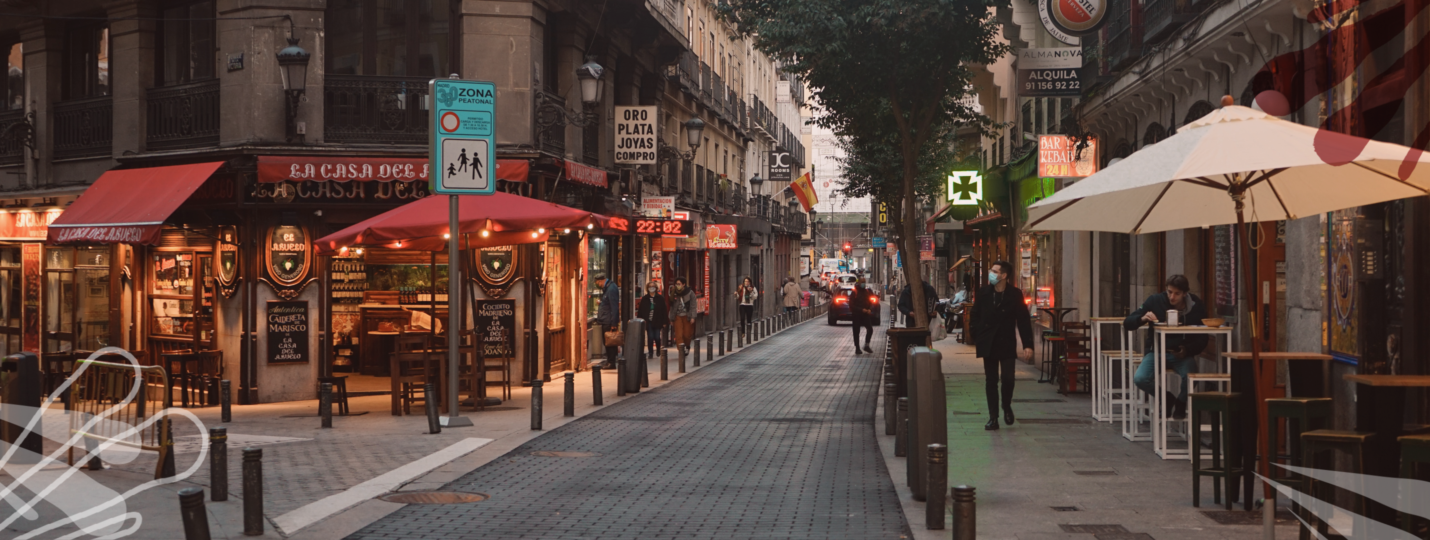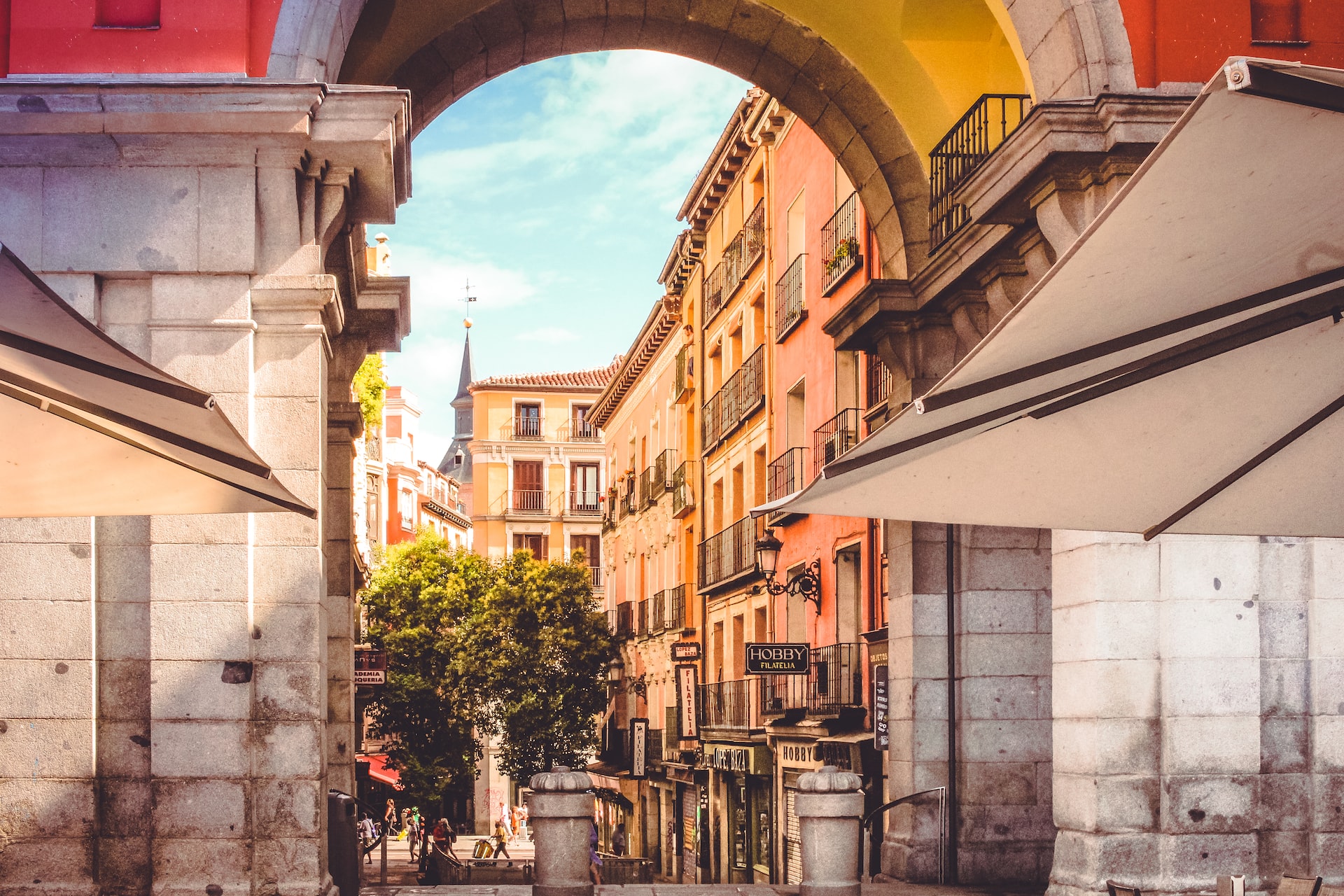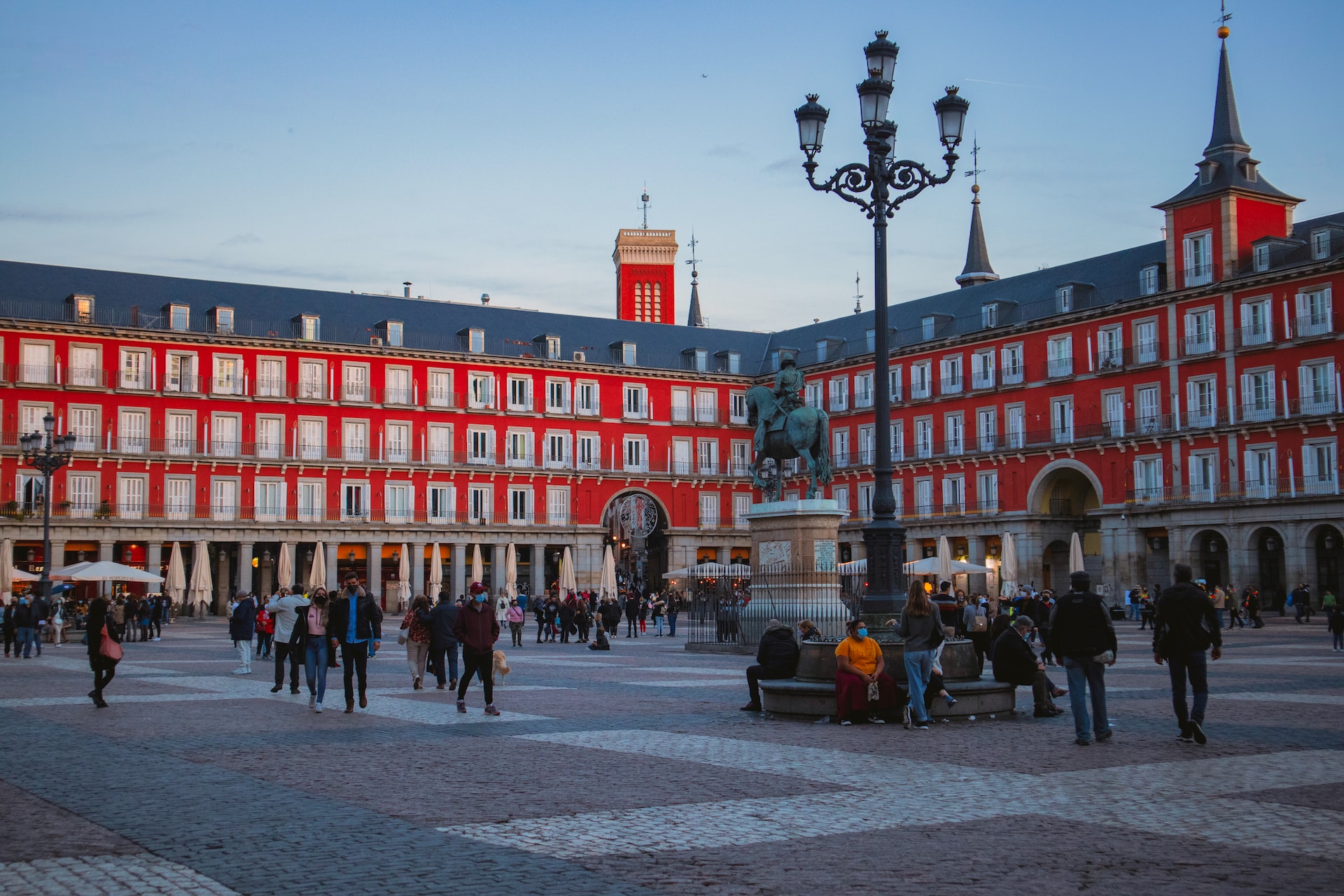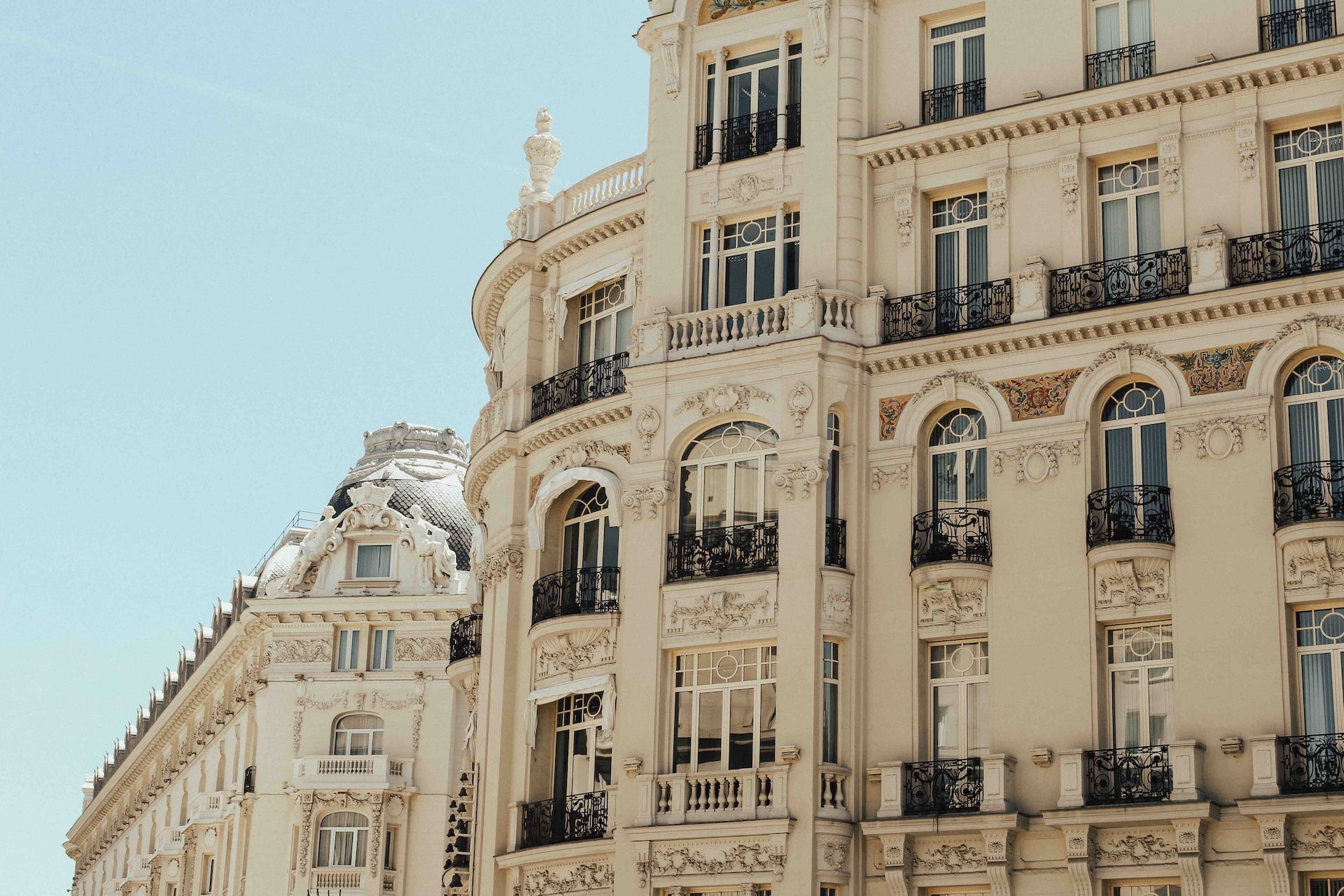
Living in Madrid: The Ultimate Guide
Relocating to Madrid has been a transformative experience for me. Everything else aside, the vibrant energy combined with the slower pace of life has been incredibly good for my well-being, and the eternal sun has warmed my bones.
If you’re planning to move to Spain but are indecisive about which city you want to live in, read on because I’ll be tempting you with the countless beauties of Madrid throughout this post. I never thought I’d fall in love with a city so quickly myself, but trust me, Madrid will steal your heart, too.

Why Move to Madrid?
Why should you pack your bags up and move to this bustling metropolis? Let me give you a couple of the too-many-to-count reasons why Madrid is the place to be.
⛱️ First off, the weather. Madrid is known for its sunny skies and mild temperatures. So forget about those dreary gray days because, in Madrid, the sun is always shining. It's the perfect place to enjoy a café con leche on a terrace or stroll through one of the city's many parks.
💃 The city's swarming with vibrant energy, and there's always something happening. Whether it's a street festival, a flamenco show, or a football match: there's never a dull moment in Madrid. In addition to fun and Madrid also offers great healthcare, an excellent transportation network.
All these factors build up a great quality of life, which comes in return for an affordable cost of living. So, if you're looking for a city with great weather, a vibrant lifestyle, effortless transportation, top-notch healthcare, and convenient living expenses, look no further than Madrid.
Living in Madrid: Advantages and Disadvantages
I had second thoughts during the process of moving to Madrid, regarding the absurdity of running away from one major city to another. I thought I’d come across the same urban chaos and unaffordable living expenses. However, upon thorough research, I saw that was not the case, and after relocating there, Madrid turned out to be just the place for me.
Madrid has its own perks and downsides, as every other city in the world. For me, though, the advantages blow the doors off the disadvantages. Nonetheless, I’ve made a list to give you an idea about what to expect.
Advantages of Living in Madrid
Convenient Cost of Living
First and foremost, although Madrid is one of the costliest cities in Spain, it still has a relatively low cost of living compared to other major European cities, making it an attractive destination for both tourists and residents. The city offers affordable housing, food, and transportation, allowing individuals and families to stretch their budgets further. Additionally, Madrid boasts a wide range of cultural and recreational activities, from museums and art galleries to parks and sports facilities, that are often available at little or no cost.
Excellent Public Transportation
Madrid has an excellent public transportation system, making it easy for residents and visitors to navigate the city. The metro network is extensive, reliable, and affordable, with frequent trains running throughout the day and night. The city also has an extensive bus network and a suburban rail system connecting the city center to outlying neighborhoods and suburbs. These transportation systems make moving around Madrid quite effortless, reducing the need for personal transportation. Such a variety of convenient public transportation options also helps decrease traffic congestion and air pollution. Furthermore, the city has bike-sharing and e-scooter options, providing even more alternative means of transportation.
Vivid Nightlife
Madrid is famous for its vibrant nightlife scene, offering something for everyone. From trendy bars and clubs to traditional taverns and live music venues: the city comes alive after dark.
The locals are known for their love to party late into the night, so you can find a place to go out at any time of the night. The city center is particularly vivid at night, with the neighborhoods of Malasaña, Chueca, and La Latina, which are all home to a wide range of options for nightlife entertainment. Madrid's nightlife is not only limited to the city center, though. You can find many entertainment places also in other surrounding neighborhoods like Salamanca, Chamberí, and Retiro.
Delicious Food and Drinks
Madrid is a paradise for foodies, offering a wide range of food and drinks from delicious and authentic Spanish cuisine. The city is known for its traditional dishes such as tapas, paella, and cocido madrileño. The local marketplaces and taverns provide the opportunity to sample these dishes at very affordable prices.
Madrid is home to a thriving culinary scene, with many top-rated restaurants and trendy fusion eateries. It's also renowned for its extensive selection of great wine, consisting of both local and international options. In addition to countless delicious options for traditional Spanish food, Madrid is also prosperous in terms of offering international cuisine.
Vibrant Social Life
There are people in Spain from literally everywhere around the world, which makes the social scene quite festive. Socializing in Madrid is incredibly enjoyable. Madrid is home to countless cultural and recreational activities, art events, festivals, and street fairs. Locals are very friendly, and there’s an ever-growing, tightly-knit network of expats in the city.
Intriguing Lifestyle
Madrid is a city renowned for its laid-back and relaxed lifestyle. The locals, known as Madrileños, take their time with everything and prioritize enjoying life. The city is also known for its nightlife, with bars and clubs staying open late into the night. There are many outdoor spaces to enjoy spending time at, such as Retiro Park and the Buen Retiro Gardens. Madrid is also home to world-renowned art museums, such as the Prado, Reina Sofia, and Thyssen-Bornemisza. The city is a perfect blend of culture and relaxation, and hence, an intriguing destination.
Disadvantages of Living in Madrid
Poor Rental Market
The rental market in Madrid is weak compared to other major cities in Europe. Housing prices are generally high, security deposits can go up to the worth of six months' rent, and the conditions of the properties usually fail to correspond to their prices.
Horrible Traffic
Madrid may not be a great destination for those who like to get around by driving, especially if they’re to travel to the center frequently. The traffic is terrible and concordantly, drivers can be aggressive, and parking is another major problem.

Related Articles
Best Neighborhoods to Live in Madrid
Salamanca
Being one of the most expensive neighborhoods of the capital, the Salamanca neighborhood is also known as the Golden Mile. Famous for its elegant and exclusive atmosphere, Salamanca is an excellent destination for those who appreciate luxury and high-end culture. It’s also home to some of the most prestigious art galleries in the city and a remarkably vibrant nightlife.
Retiro
The Retiro neighborhood in Madrid is a charming and upscale area that offers a perfect blend of elegance and nature. It’s known for its tree-lined streets, elegant architecture, and high-end shops and restaurants. The neighborhood is also home to the famous Calle de Serrano, which is a popular shopping destination with designer boutiques and luxury brands. Retiro is full of beautiful parks and gardens, such as the Parque del Retiro, which is one of the city’s most iconic and beloved parks in Spain. The availability of such spaces enable the residents of Retiro to engage in various sports activities.
Sol
The Sol neighborhood in Madrid is a bustling and historic area located at the heart of the city. It's home to some of the city's most iconic landmarks and tourist attractions, such as the Plaza Mayor, the Royal Palace, and the Gran Vía. The neighborhood is also famous for its lively atmosphere: plenty of bars, restaurants, and shops to explore. The nightlife in Sol is also vibrant and diverse, offering numerous options for everyone, from traditional taverns to trendy clubs. Sol is a perfect destination for those who want to experience the true spirit of Madrid: a mix of history, culture, and fun all in one place.

Transportation
Madrid has an extensive and efficient public transportation system, making it easy to get around. The subway network, also known as the Metro, is one of the most popular ways to travel around the city. It has 13 lines and over 300 stations, constituting one of the largest subway networks in Europe. Running until late at night, the Metro is a fast and convenient way to reach most destinations within the city.
In addition to the subway, Madrid has an extensive bus network with over 150 lines covering the entire city. Buses run from 5:00 am to midnight and offer a more flexible way to access destinations that aren’t reachable by the subway.
Madrid also has a light rail system, known as the tram, which serves the suburbs. The tram has four lines and is a convenient way to reach destinations such as Alcala de Henares and Coslada.
The suburban trains, known as Cercanias, are operated by Renfe–the national railway company–and they provide service to destinations outside Madrid, such as Toledo, Segovia, and El Escorial.
Driving in Madrid can be challenging due to the immense traffic and limited parking. The city center is a restricted traffic zone known as Madrid Central, which requires a special permit to drive in. The city also has a bike-sharing service, BiciMad, which allows users to rent bicycles for short trips inside the city.
Overall, Madrid has a well-connected and diverse transportation system that makes it easy to get around the city: whether by subway, bus, tram, suburban train, or bike.
Accommodation
Madrid offers a variety of accommodation options for those looking to live in the city. Housing prices in Madrid vary depending on the property type, location, and size.
One popular housing option is to rent an apartment, which can be found in various neighborhoods and ranges from studios to multi-bedroom units. Many apartments come furnished or partially furnished. Another option is to stay in a shared apartment, also known as a piso compartido, which is a more budget-friendly option and can be a great way to meet other people.
Other options are detached homes and townhouses, which are popular among families and those looking for more space. These properties typically tend to be more expensive than apartments.
Although it’s still considerably cheaper than most other European cities, Madrid is relatively expensive compared to other Spanish cities in terms of housing. While Salamanca, Chamberí, and Retiro are some of the most pricey areas, Tetuán, Vallecas, and Fuencarral-El Pardo tend to be more affordable.
There are various real estate agencies that can help you find great deals on rental properties in Madrid. However, it’s important to note that rental prices have been increasing in recent years. Therefore, it may be challenging to find an affordable apartment in some areas, especially if you are looking for a property in a central location. Doing thorough research online beforehand may help ease the apartment-hunting process.
La Latina
La Latina is a historic neighborhood located in the heart of Madrid, known for its charming narrow streets and traditional architecture. It has a vivacious atmosphere with plenty of bars, taverns, and restaurants. La Latina is also home to some of the most iconic and picturesque plazas in Madrid, such as the Plaza de la Paja, as well as plenty of street vendors and local shops selling handmade crafts. The neighborhood is perfect for those who want to experience the authentic, traditional side of Madrid’s culture and lifestyle.
Malasaña
Malasaña is a neighborhood located in the center of Madrid, renowned for its bohemian atmosphere, alternative culture, and vibrant nightlife. It’s full of vintage clothing shops, trendy bars, and cozy cafes. The neighborhood also contains many historic buildings and monuments, such as the Church of San Ildefonso and the Conde Duque Cultural Center. Malasaña offers a unique and exciting experience for those looking to live on the alternative side of Madrid. Many young people and artists call Malasaña home.
Moncloa-Aravaca
Located in the western part of Madrid, Moncloa-Aravaca has many upscale residential areas and green spaces, such as Casa de Campo Park and Buen Retiro Park. The neighborhood is also home to several prestigious universities, such as Complutense University and the Polytechnic University of Madrid. Moncloa-Aravaca is a safe and quiet neighborhood, making it a popular choice among families and expats. It offers a variety of international restaurants and shops. All in all, it’s a great place to live in Madrid for those looking for a high-quality and peaceful lifestyle.

Food and Drinks
Madrid is quite celebrated for its rich culinary culture. The traditional cuisine in Madrid includes dishes such as Cocido Madrileño, a hearty stew made with chickpeas, vegetables, and meat; Callos a la Madrileña, a spicy pork and tripe stew; and Huevos rotos which is fried eggs served over a bed of fried potatoes. Churros con Chocolate–a traditional dish consisting of fried dough pastries dipped in hot chocolate–and Tortilla de Patatas–a thick potato and onion omelet–are two other famous dishes of Madrid.
Madrid is also known for its tapas culture: many bars and restaurants you’ll step into will probably serve tapas.
In addition to traditional Spanish dishes, Madrid is prosperous in terms of international food, as well. The city offers numberless restaurants offering cuisines from around the world: Italian, Chinese, and Indian. Madrid also has a growing number of vegetarian and vegan restaurants to cater to different dietary needs.
Now, let’s talk about beverages: Madrid is also famous for its wine and beer. The region that Madrid is part of is one of the best grape-growing regions in Spain, and you can find a wide variety of local wines made from these grapes in the city’s restaurants and bars. Beer is another popular beverage in Madrid: many bars and pubs offer a selection of local and international beers.
In short, Madrid offers a diverse culinary scene that caters to both traditional and modern tastes. Whether you’re in the mood for classic Spanish meals or international cuisine, Madrid has a dish to offer for every palate.
Activities
Madrid is a city full of history, art, culture, and entertainment, which offers endless enjoyable activities. Here are 10 things not to be missed:
Activites you can enjoy in Madrid:
- Visit the Prado Museum: One of the most famous art museums in the world, the Prado features works by Spanish masters such as Velázquez and Goya, as well as works by European masters such as Hieronymus Bosch and Titian.
- Take a stroll through Retiro Park: This beautiful park is a popular spot featuring gardens, lakes, and monuments.
- See the Royal Palace: The official residence of the Spanish royal family, the palace is open to visitors and offers a glimpse into the opulent lifestyle of the monarchy.
- Sample local cuisine: Madrid is known for its delicious food, so make sure you try famous dishes such as tapas, paella, and churros con chocolate.
- Visit the Templo de Debod: An ancient Egyptian temple gifted to Spain in the 1960s and reassembled in Madrid.
- Go shopping on Gran Via: One of the city's main shopping streets, Gran Via is home to a wide variety of shops, department stores, and theaters.
- Catch a football match: Madrid is home to two of the most famous football clubs in the world--Real Madrid and Atlético Madrid--and catching a game at their stadiums is an experience not to be missed.
- Explore Malasaña and Chueca: These two neighborhoods are known for their bohemian atmosphere, trendy boutiques, and lively nightlife.
- Visit the Santiago Bernabéu Stadium: Home of Real Madrid and one of the most iconic stadiums in the world.
- Take a day trip to Toledo: This ancient city is only a short train ride away from Madrid and offers a glimpse into Spain's rich history.
Is Madrid Safe?
🚨 Madrid is generally a safe city, especially when compared to other major cities in Western Europe. It has a relatively low crime rate, and it's safe to walk around during the day and night in most areas. However, pickpocketing is a common crime in the city, particularly in crowded areas like tourist attractions and public transportation. You should keep your valuables close and be mindful of your surroundings.
Exploring Madrid’s Social Landscape
Is it easy to meet new people and other expats in Madrid? But of course! The city has a large expat community and offers plenty of opportunities to socialize, such as social clubs, interest groups, bars, and parks. Furthermore, Madrid’s residents are friendly and welcoming, making it easy to connect with locals.
Tips for Meeting New People in Madrid
- Join a social/interest-based group or club, such as a sports team, language exchange group, or cultural organization.
- Attend events and gatherings, such as festivals, concerts, and exhibitions.
- Take a class or workshop: cooking class, dance class, art class, etc.
- Volunteer for a local organization or charity.
- Visit popular socializing spots like bars, clubs, and parks.
- Take part in activities like language exchanges with locals or other expats.
- Attend Meetups and other networking events for expats in the city.
- Use social media platforms to connect with people who share your interests.
- Utilize online platforms like Couchsurfing or language exchange apps to connect with locals or other travelers.
- Be open-minded and friendly, and don't be afraid to initiate conversations with people you meet.
Before Moving to Madrid: Things You Need to Know
1
The official language is Spanish, so it is helpful to learn at least basic Spanish before moving there.
2
The official language is Spanish, so it is helpful to learn at least basic Spanish before moving there.
3
The city is known for its rich culture and history, so get ready to visit many museums, art galleries, and historical sites.
4
Madrid is also a popular destination for food and nightlife, with many restaurants, bars, and clubs to choose from.
5
The city has an excellent public transportation system, including the metro, buses, and trains.
6
Madrid is a safe city, but nevertheless, it's best to be aware of your surroundings and take precautions to protect yourself and your belongings.
7
Although it's cheaper than most other major European cities, the cost of living in Madrid is relatively high compared to other cities in Spain.
8
Finding a place to live can be challenging, especially in the city center and during peak season. Do your research beforehand to get a good deal in the shortest time possible.
9
The city has a large expat community. Prepare to be networking in no time.
Living in Madrid: The Wrap-Up
Living in Madrid can be an extremely rewarding experience, considering the city’s rich culture and history, delicious food, and vibrant nightlife. No need to mention the perfect Mediterranean climate and the good balance between work and leisure.
If you’re considering relocating to Madrid, I’d highly encourage you to take the plunge. It’s a city that offers something for everyone, and you won’t ever regret relocating there, not for the slightest moment.
Frequently Asked Questions
What are the best neighborhoods for digital nomads and expats to live in Madrid?
Some popular neighborhoods for digital nomads and expats in Madrid include: Malasaña, Chueca, and Retiro. These areas offer a mix of affordable housing options, good transportation links, and a vibrant social scene.
What is the cost of living like in Madrid for digital nomads and expats?
Madrid is generally considered to be an affordable city for digital nomads and expats. The cost of housing, food, and transportation is relatively low compared to other major European cities. However, costs can vary depending on the neighborhood you choose to live in.
What is the best way to find housing in Madrid?
There are several ways to find housing in Madrid, including online platforms such as Idealista, Fotocasa, and Habitaclia. You can also find apartments and rooms for rent on websites like Airbnb and Booking.com. Other options include contacting a local real estate agent or looking for classified ads in newspapers and online.
What are the visa requirements for digital nomads and expats living in Madrid?
Digital nomads and expats from the European Union can live and work in Madrid without a visa. Non-EU citizens may need a work or residence visa to live and work in Madrid, which can be obtained through the Spanish consulate in their home country.
What are the best coworking spaces in Madrid for digital nomads?
Some popular coworking spaces for digital nomads in Madrid include Impact Hub Madrid, La Nave, and The Cube. These spaces offer a variety of amenities such as high-speed internet, meeting rooms, and networking events.
How is the internet connectivity in Madrid for digital nomads?
Madrid has good internet connectivity overall. Most cafes, coworking spaces and apartment buildings offer Wi-Fi. And also 4G and 5G mobile internet is widely available in the city.
What are the best places to network with other digital nomads and expats in Madrid?
Some popular places to network with other digital nomads and expats in Madrid include coworking spaces, meetup groups, and expat-friendly bars and cafes. Many digital nomads also find networking opportunities through social media groups, such as Facebook or LinkedIn groups.
Is Madrid a good place to live?
Madrid is generally considered a good place to live, with its rich history, vibrant cultural scene, and affordable cost of living. However, this can vary based on individual preferences and priorities.
What salary do you need to live in Madrid?
The salary needed to live comfortably in Madrid will depend on factors such as your housing and lifestyle expenses. A salary of around €30,000 to €40,000 per year is considered a reasonable starting point for most people.
Is it expensive to live in Madrid?
Madrid is considered an affordable city compared to other major European cities. The cost of living is relatively low, especially in terms of housing, food, and transportation. However, prices can vary depending on the neighborhood you live in.
What are the pros and cons of living in Madrid?
Pros of living in Madrid include a rich cultural heritage, vibrant social scene, and affordable cost of living. Cons include high levels of pollution and traffic congestion in some areas, as well as a hot and dry climate in the summer months.
Do they speak English in Madrid?
English is widely spoken in Madrid, especially in tourist areas and among younger generations. However, knowing some basic Spanish is always helpful and appreciated.
Do you need a car to live in Madrid?
No, you do not need a car to live in Madrid. The city has an extensive public transportation network, including buses, trains, and metro.
What is a high salary in Madrid?
A high salary in Madrid will depend on individual expenses and lifestyle, but salaries of €70,000 or more are considered high by most standards.
What's it like to live in Madrid as a foreigner or expat?
Living in Madrid as a foreigner or expat can be a positive experience, with the city offering a rich cultural heritage, vibrant social scene, and affordable cost of living. There may be some challenges in adapting to the local culture and language, but there is a large expat community in Madrid for support.
Which city is a better city for expats to live in Madrid or Barcelona?
Both Madrid and Barcelona are great cities for expats, each offering a unique cultural experience and quality of life. Ultimately, the best city will depend on individual preferences and priorities, such as job opportunities, cost of living, and cultural attractions.












